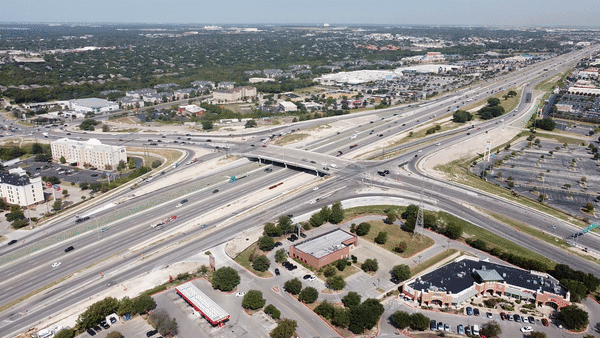A road configuration that can improve traffic flow — but also has the potential to confuse drivers at first — is scheduled to open Saturday on the Parmer Lane bridge that crosses Interstate 35.
The so-called diverging diamond interchange directs traffic entering the bridge to the left side of the road, so vehicles turning on the I-35 frontage lanes won't have to cross in front of oncoming traffic.
The traffic configuration, which has been used in France since the 1970s, is intended to squeeze even more capacity out of the busy intersection that can see upwards of 60,000 vehicles on an average day.
The Parmer Lane bridge over I-35 is scheduled to close Friday at 8 p.m. so crews can change the striping and put up new signs. The bridge should reopen by noon on Saturday with police on scene to help direct traffic through the new configuration.
The Austin area's first diverging diamond interchange opened in 2015 at University Boulevard at I-35 in Round Rock. The second one, at Slaughter Lane and MoPac, was completed in 2020. A fourth is in the works at I-35 and Williams Drive in Georgetown.
"This design absolutely facilitates [more traffic] when you have two signals, a signal on either side of the freeway," UT Austin professor of transportation engineering Kara Kockelman said. "That is typical of Texas because we are so married to the frontage road design."
The roadway configuration is among a number of alternative junction designs in TxDOT's Roadway Design Manual. Others include the "displaced left" intersections found at William Cannon and U.S. 290 in Oak Hill and at RM 1431 and Parmer Lane in Cedar Park.
The diverging diamond interchange at Parmer Lane and I-35 is part of a $24.6 million TxDOT project that included adding right-turn lanes at Lamar Boulevard and Parmer Lane, reconstructing entrance and exit ramps south of Parmer Lane and widening the northbound frontage road.

"We've seen the congestion grow in the area, and we needed to improve the flow of traffic but also improve safety in that area as well," TxDOT spokesperson Diann Hodges said.
Diverging diamond interchanges tend to increase driver safety by virtually eliminating left-turn crashes and reducing other collisions. But pedestrian advocates say they don't do much for people walking or riding a bicycle, even when projects add new sidewalks like this one does.

"Parmer and I-35 from a pedestrian point of view has been a nightmare," said Jay Blazek Crossley, executive director of Farm&City, a nonprofit think tank focused on issues like transportation and land use.
"It's good if TxDOT can design things to work more efficiently and safer for people who are inside of cars, but the main goal should be designing places that are safe and multimodal for humans," he said.

Construction on the I-35 at Parmer Lane project won't be complete after the diverging diamond interchange opens Saturday. Some sidewalks still need to be constructed, and work hasn't yet finished on the right-turn lanes at Parmer and Lamar. TxDOT estimates everything will be done by January 2022.












